Senior Projects 2024
Software Development Senior Projects 2024
Alex Kristian & Neil Keohane
“Blue Raven Solutions App”
Client: Blue Raven Solutions
Our project with Blue Raven Solutions is to help advance their company’s mission by further developing tools to provide trusted supply chain solutions designed to keep USA military technology, vehicles and other equipment operational, ready and safe. We will create an internal web application that allows users to categorize, search, track, and view government price requests for required parts. The purpose of this site is to allow users to search and mark the request as one that the company will attempt to bid. The price requests are going to be categorized based on custom user filter criteria such as manufacturer or specific part number. This sorting algorithm will need to be revised and revamped to be more efficient. We are also going to add a live search feature that will allow the ability for users to make quick searches for any price requests they need to view.
Aliyah Smith-Bradley & Alexandra Gardner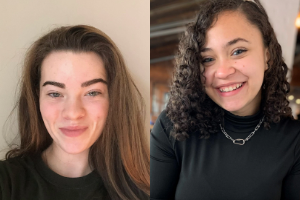
“Our Green Place”
Client: Professor David Gordon
"Our Green Place" is an innovative web application dedicated to addressing the critical environmental issue of deforestation. This platform not only educates users about the impact of deforestation but also offers accessible and user-friendly trails to reconnect individuals with nature. Each trail is thoughtfully labeled with information such as accessibility, child-friendliness, beginner-friendliness, and scenic attributes. Our web application goes beyond just guiding users through trails; it also provides valuable details on parking access, ensuring a seamless and convenient experience for those seeking an escape from the hustle and bustle of city life. If you're craving to immerse yourself in the tranquility of nature and contribute to the fight against deforestation, "Our Green Place" is the ideal companion for your eco-friendly adventure.
Brendan Clark & Audrey Versteegen
“Refining LEGOLAS”
Client: Dr. Mary Lowe
The LEGOLAS robot is a LEGO-based Low-cost Autonomous Scientist that was created by students under Dr. Ichiro Takeuchi at the University of Maryland. This robot mixes materials with a pipet and measures the pH of the mixtures with a pH sensor. The primary issue with this system is that its pH sensor is often inaccurate due to the diameter of the mixing wells not being much larger than the pH sensor itself; often resulting in the pH sensor hitting the wall of the well and is unable to collect any sort of valuable data. The goal of this project is to incorporate computer vision into the LEGOLAS system. By using machine learning to identify the well's location, it is possible to make live adjustments to the positioning of the pH sensor before it tries to make a measurement. Additionally, a warning system will be implemented to alert the user in case the pH sensor misses so that the user can reset it.
Bolden Blades & Juliana Merlino 
“Managerial Dashboard”
Client: Carrie Schuckle, Technical Manager at ABS Wavesight
Our client oversees two teams of software engineers. The leader of each of these teams displays their team’s progress using Azure DevOps, a website for Software Development that teams use to display their project data. Each team's leader has liberty to design their dashboard how they see fit to best display the data. This is a problem for Carrie because each board has data displayed completely differently and in different locations and this makes it hard for her to compare the team's progress. She has tasked us with creating a new dashboard that can pull the data from the projects her teams are working on and display them in a format that is easier to compare against each other. An example of what Carrie would like to view on this dashboard would be the cycle time of the 1.X product team versus the cycle time of the 2.X product team. This visual would improve her ability to manage her employees and see how they are progressing on their tasks. For testing purposes we will create two “dummy” projects to populate the information into our dashboard to view since our client cannot share her current projects with us. We plan to create a dashboard that is easy to use and customize to help our client better assist her teams in their development process.
Christoph Koch-Paiz & Oliver Koch-Paiz
“Psychology Dissertation Matching Program”
Client: Traci Martino
The goal of this project is to automate the process of matching doctoral students (seeking a degree in Psychology) with a dissertation chair (faculty member). Each year, doctoral students are required to complete their dissertations, a comprehensive and in-depth research document that students at the doctoral level complete as part of their degree requirements. Throughout this process, students work alongside a dissertation chair who guides and oversees the research process. Students will meet with various dissertation chairs, participating in a mutual ranking process to find their match. In previous years, our client used a piece of software on a CD to generate these matches. This software is now outdated and no longer works, requiring our client to manually perform the matches based on the rankings submitted to her. The purpose of our software is to make our client’s life easier by creating a user-friendly application that automates the matching process. Students and faculty members will be able to rank each other on our web application and a complex algorithm will perform the matches based on these rankings.
Collin Katz & Kobe Middleton 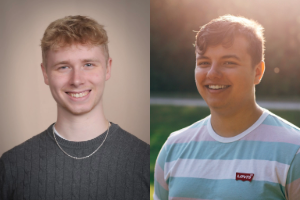
“Loyola Fit Sports Management System”
Client: Tyler Zorn
The goal of LoyolaFit is to create a dynamic, robust website that can handle all the needs of Recreation and Wellness administrators while maintaining a user-friendly experience. You have likely used the current solution IMLeagues if you have ever registered for a fitness class at the FAC or participated in a club or intramural sport. LoyolaFit seeks to improve the user experience offered by IMLeagues by removing ads, and will offer students and faculty multiple ways to navigate to their desired actions, themed with the Loyola brand. LoyolaFit will offer our users a familiar application that draws on design patterns from other applications that students and faculty will be familiar with such as Moodle, SharePoint (Inside Loyola), and Outlook. Once complete, LoyolaFit will unify the many sports-oriented functionalities of IMLeagues such as team registration, dues collection, officiating, and league management with a custom Loyola package that incorporates FAC community subscription purchases, fitness classes, and forms. Ultimately, replacing IMLeagues with LoyolaFit will offer Loyola students, faculty, alumni, and community members a more navigable and comprehensive FAC and club sports experience.
Peter Hope & Emma Smith
“Additional getGFTD Features”
Client: Nina Guise-Gerrity, getGFTD
The application getGFTD was created to make sending gifts more personable in the modern age. Currently, the application allows users to create wishlists of items which can then be gifted to them by other users. The exact cost of the item is transferred to the recipient, who is then able to receive the item that they wished for. For our capstone, we will add key features and functionality that will enhance the users’ experience and capabilities and help take getGFTD to a new level in the gifting market.
By nature, getGFTD encourages environmentally friendly practices through the elimination of packaging and shipping. This semester, we will be working to create an additional functionality that aligns with this environmentally conscious aspect by integrating access to the top companies that give back to the environment into the app. In a similar vein, we will be using webhooks to create a browser extension that will allow users to add items to their wishlists while shopping online.
Another core of getGFTD is the personability that comes with gifting what they really want. We will work to close that loop by adding customizable thank you card functionality to show appreciation. We will also add scheduling features to make sure you never miss a special event.
Horacio Trujillo & Mason Hall
“Madison Marsh Hunting Club Website”
Client: Tim Sauer, President of Madison Marsh Hunting Club
The goal of our project is to create a visually appealing, informational, and manageable
website for the Madison Marsh Hunting Club and the Dorchester County community. Our
client requested a simple but intuitive website to manage the members of his hunting
club and to inform the community of Dorchester County’s rich history. Some of the
functionality of this project includes editable forum pages, reserving feeders and
stands on property, manage members’ accounts and upload hunting licenses, use interactive
maps, and admin-edit privileges to maintain the websites picture galleries, links,
and forums.
Ryan Gehan & Peter Pressley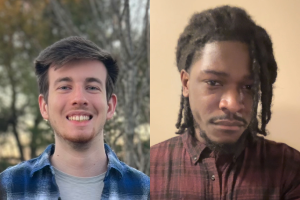
“Teaching Chemistry through Augmented Reality”
Client: Irene Bal
The goal of this project is to create a library of Augmented Reality (AR) "Experiences" showcasing the formation of various chemical bonds to help students learn chemistry. These experiences will be 3D models that the user will be able to move around, look at, and interact with, and will be created using Unity. Users will be able to access these AR Experiences through a dedicated website that we will create, providing a centralized platform for students to explore and examine these exercises through QR codes. Our Client will then put these codes in a textbook that she is making with her students.
Research Senior Projects 2024
David Avallone & Kelly Reynolds 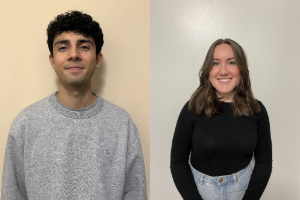
“Speeding up Iris Recognition using Distributed Computing”
Research Advisor: Dr. Hoang Bui
This project aims to utilize machine learning models to recognize irises from images of eyes. We will begin by isolating the iris from the overall image of the eye utilizing computer vision techniques. We will then utilize various machine learning models to detect the irises and determine which model is most accurate for this problem. While iris recognition in general has many benefits, it is not useful in many real-life situations if the process is slow. We aim to research different ways to speed up this process to provide more general uses. Iris identification is becoming very prevalent in today's society with various medical uses as well as biometric security applications. Fast recognition will be necessary for everyday use. Therefore, we will be recognizing these irises and utilizing distributed computing to find the fastest, most accurate technique.
Joshua Brooks & Sajiv Gnanasekaran 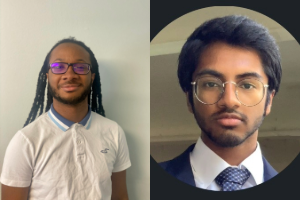
“Predicting a LLM’s ability to solve a Coding Problem”
Research Advisor: Dr. Nguyen Ho
Dr. Ho has asked us to continue her research on the ability of Large Language models (LLMs), including Chat-GPT3.5, ChatGPT4, GitHub CoPilot, Google’s Duet AI, JetBrains AI Assistant, and Amazon’s Code Whisperer to solve complex programming problems. Currently, analysts are investigating the long-term effects of these tools on the labor market. Employers are wondering if LLMs have the ability to replace their software developers, and those developers are wondering if their jobs are still secure. Our research aims to answer this question, and provide concrete metrics on each of these LLMs’ actual abilities in comparison to human programmers.
Dr. Ho’s research has already found that higher difficulty level and higher Lexicon Count correlate to ChatGPT giving incorrect answers. In order to continue this investigation, we plan to train a new machine learning model that can receive an input of a given text programming problem and evaluate how well these LLMs would answer it, giving back a score-like metric. To train this model, we need to aggregate samples of programming questions over a wide range of difficulties, with different levels of readability and advanced language. We then need to feed these questions into the LLMs and gather their answers, and score them based on efficiency. We can then train a semi-supervised Naïve Bayes text classifier to analyze new problems.
Karis Woo
“Code Vulnerability Detection”
Research Advisors: Sibren Isaacman, Dave Binkley
The goal of my project is to use machine learning to detect potential security vulnerabilities in code. Building upon previous research, the machine learning model will use a combination of deep neural networking and term frequency. The model will be given a name, break it down to read the name’s characters, and assign it a value. If the value is higher than the deciding threshold’s, it will deem it a vulnerability. This research is exploring the viability of a new approach to defect prediction based on word frequency and could see use in assisting developers in deciding whether they should use alternative, safer methods to replace the highlighted, vulnerable code.
Senior Projects 2017 Senior Projects 2018 Senior Projects 2019 Senior Projects 2020 Senior Projects 2021 Senior Projects 2022 Senior Projects 2023